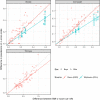Exploring an algorithm to harmonize International Obesity Task Force and World Health Organization child overweight and obesity prevalence rates
- PMID: 35193166
- PMCID: PMC9285550
- DOI: 10.1111/ijpo.12905
Exploring an algorithm to harmonize International Obesity Task Force and World Health Organization child overweight and obesity prevalence rates
Abstract
Background: The International Obesity Task Force (IOTF) and World Health Organization (WHO) body mass index (BMI) cut-offs are widely used to assess child overweight, obesity and thinness prevalence, but the two references applied to the same children lead to different prevalence rates.
Objectives: To develop an algorithm to harmonize prevalence rates based on the IOTF and WHO cut-offs, to make them comparable.
Methods: The cut-offs are defined as age-sex-specific BMI z-scores, for example, WHO +1 SD for overweight. To convert an age-sex-specific prevalence rate based on reference cut-off A to the corresponding prevalence based on reference cut-off B, first back-transform the z-score cut-offs and to age-sex-specific BMI cut-offs, then transform the BMIs to z-scores and using the opposite reference. These z-scores together define the distance between the two cut-offs as the z-score difference . Prevalence in the target group based on cut-off A is then transformed to a z-score, adjusted up or down according to and back-transformed, and this predicts prevalence based on cut-off B. The algorithm's performance was tested on 74 groups of children from 14 European countries.
Results: The algorithm performed well. The standard deviation (SD) of the difference between pairs of prevalence rates was 6.6% (n = 604), while the residual SD, the difference between observed and predicted prevalence, was 2.3%, meaning that the algorithm explained 88% of the baseline variance.
Conclusions: The algorithm goes some way to addressing the problem of harmonizing overweight and obesity prevalence rates for children aged 2-18.
Keywords: IOTF; WHO; harmonization; obesity; overweight; prevalence.
© 2022 The Authors. Pediatric Obesity published by John Wiley & Sons Ltd on behalf of World Obesity Federation.
Conflict of interest statement
Tim J. Cole declares the following conflicts of interest: he developed the LMS method with Peter Green and was first author on papers describing the IOTF cut‐offs., , Tim Lobstein was also an author on the latter paper.
Figures




Similar articles
-
An improved algorithm to harmonize child overweight and obesity prevalence rates.Pediatr Obes. 2023 Jan;18(1):e12970. doi: 10.1111/ijpo.12970. Epub 2022 Aug 23. Pediatr Obes. 2023. PMID: 35997305 Free PMC article.
-
Extended international (IOTF) body mass index cut-offs for thinness, overweight and obesity.Pediatr Obes. 2012 Aug;7(4):284-94. doi: 10.1111/j.2047-6310.2012.00064.x. Epub 2012 Jun 19. Pediatr Obes. 2012. PMID: 22715120
-
Defining overweight and obesity in pre-school children: IOTF reference or WHO standard?Obes Rev. 2011 Apr;12(4):295-300. doi: 10.1111/j.1467-789X.2010.00748.x. Obes Rev. 2011. PMID: 20492539
-
Height, weight and BMI percentiles and nutritional status relative to the international growth references among Pakistani school-aged children.BMC Pediatr. 2012 Mar 19;12:31. doi: 10.1186/1471-2431-12-31. BMC Pediatr. 2012. PMID: 22429910 Free PMC article.
-
Overweight and obesity in infants and pre-school children in the European Union: a review of existing data.Obes Rev. 2010 May;11(5):389-98. doi: 10.1111/j.1467-789X.2009.00639.x. Epub 2009 Jul 10. Obes Rev. 2010. PMID: 19619261 Review.
Cited by
-
Anti-Obesity and Anti-Inflammatory Synergistic Effects of Green Tea Catechins and Citrus β-Cryptoxanthin Ingestion in Obese Mice.Int J Mol Sci. 2023 Apr 11;24(8):7054. doi: 10.3390/ijms24087054. Int J Mol Sci. 2023. PMID: 37108217 Free PMC article.
-
Menstrual Changes in Women Who Undergo Sleeve Gastrectomy in Saudi Arabia.Cureus. 2024 Aug 4;16(8):e66109. doi: 10.7759/cureus.66109. eCollection 2024 Aug. Cureus. 2024. PMID: 39229433 Free PMC article.
-
Adolescent overweight and obesity in Ireland-Trends and sociodemographic associations between 1990 and 2020.Pediatr Obes. 2023 Feb;18(2):e12988. doi: 10.1111/ijpo.12988. Epub 2022 Oct 26. Pediatr Obes. 2023. PMID: 36287113 Free PMC article.
-
Differences in Classification Standards For the Prevalence of Overweight and Obesity in Children. A Systematic Review and Meta-Analysis.Clin Epidemiol. 2022 Sep 1;14:1031-1052. doi: 10.2147/CLEP.S375981. eCollection 2022. Clin Epidemiol. 2022. PMID: 36071986 Free PMC article. Review.
-
Muscle Quality Index in Morbidly Obesity Patients Related to Metabolic Syndrome Markers and Cardiorespiratory Fitness.Nutrients. 2023 May 25;15(11):2458. doi: 10.3390/nu15112458. Nutrients. 2023. PMID: 37299421 Free PMC article.
References
-
- WHO . Obesity: preventing and managing the global epidemic. Report of a WHO Consultation Geneva, 3–5 June 1997. WHO/NUT/98.1. WHO; 1998. - PubMed
-
- Garrow JS, Webster J. Quetelet's index (W/H2) as a measure of fatness. Int J Obes (Lond). 1985;9:147‐153. - PubMed
-
- Cole TJ. Method for assessing age‐standardized weight‐for‐height in children seen cross‐sectionally. Ann Hum Biol. 1979;6:249‐268. - PubMed
MeSH terms
LinkOut - more resources
Full Text Sources
Medical

